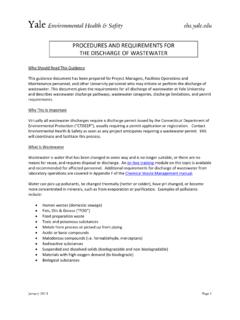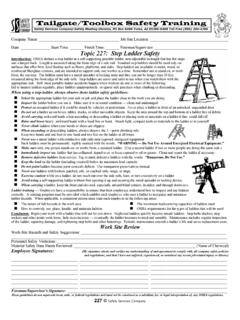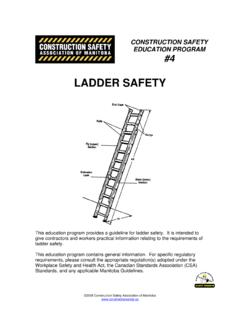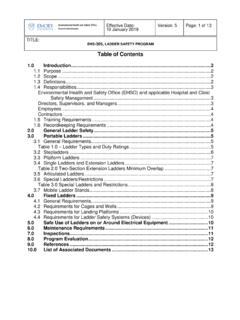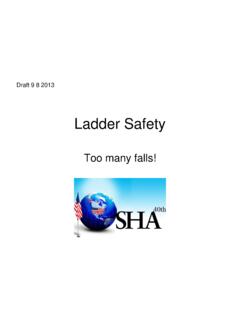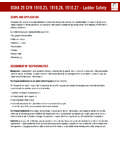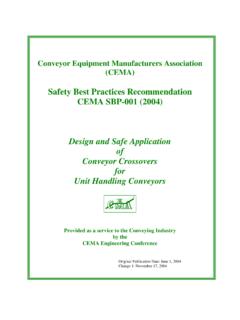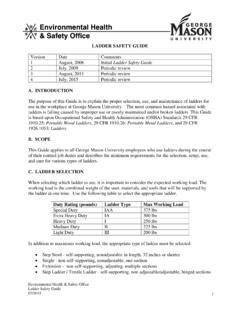Transcription of Purpose Hazards - Yale Environmental Health and Safety
1 Bulb Changing Safety Procedure 06/01/2015 Page 1 Equipment/Task: RE-LAMPINGL ocation/ Department: FACILITIES OPERATIONSP urpose A light bulb change is something almost everyone will have done in his or her lifetime. Although the actual task of changing a bulb can be quick, it s important to understand how to identify potential Hazards and how to mitigate them. As a whole, this procedure provides general guidelines to change a light bulb safely. This procedure applies to bulb changing in complex environments with a variety of Hazards such as fall and electric shock. This procedure would not apply, for example, to changing a light bulb in a desk or floor lamp where the fixture can simply be unplugged.
2 Hazards Sprain, Strain, Muscular Tears Hazards : Injury resulting from awkward posture and incorrect lifting technique Solutions: Avoid awkward postures. Use appropriately sized and placed ladders or scaffolds to provide safe access to the work. Follow correct methods for lifting with your legs and not with your back. Ask for assistance when an item may be too heavy, large, or awkward. Slips, Trips and Falls Hazards : Injury resulting from working at heights, spilled liquids or foods on the surfaces, obstacles on the floor, or uneven surfaces Injury resulting from a fall after being shocked when working on an energized fixture Solutions: Only use ladders and/or scaffolds after receiving training.
3 Ladders and scaffolds must be inspected prior to each use by a competent person (see Limitations). Only use ladders that are appropriate for the job. Only replace a bulb if the fixture is de-energized (see Electric Shock hazard). Inspect the floors around the work area before beginning. Remove or clean up any spills or obstacles that may create a slip or trip hazard as soon as possible. Store equipment out of pedestrian walkways and door openings where they will not create tripping Hazards . Wear slip resistant shoes. Lacerations, Cuts, Fractures, and Bruises Hazards : Cuts resulting from sharp edges and broken bulbs. Hand/fingers caught in equipment pinch points or between the load and other objects.
4 Solutions: Visually inspect the bulb and fixture for damaged or exposed components. Do not attempt to remove broken bulbs. Do not apply excessive force to remove bulbs. Bulb Changing Safety Procedure 06/01/2015 Page 2 Consider wearing gloves suitable for the application. Walk the route before using the equipment. Make note of obstacles and floor conditions. Remove obstacles where permitted and possible. Be mindful of pinch points or similar situations. Flying Objects Hazards : Injury resulting from debris, a broken bulb, or fixture components. Potential contamination to food or food related equipment. Solutions: Always wear eye protection when using ladders, scaffolds, and performing any task associated with a bulb change.
5 Never change a bulb over food or operating food preparation equipment. Methods to minimize the risk to process may include removing the food ingredients/equipment under the fixture and/or covering it with a clean sanitary plastic cover. Electric Shock Hazards : Injury resulting from being shocked when working on an energized fixture. Solutions: Only replace a bulb if the fixture is de-energized according to the guidelines included in the Proper Setup and Use section of this procedure. Always use fiberglass ladders. Burns Hazards : Injury resulting from contact with a hot bulb or fixture Solutions: Turn off the light fixture and wait for it to cool down before attempting to remove it. Limitations This procedure is for bulb changing in complex environments with a variety of Hazards such as fall and electric shock.
6 Do not test or attempt to change a fixture s ballast. Bulb changing is permitted by qualified workers when all of the following conditions are present: o The fixture and bulb are not damaged. o There are no exposed electrical connectors. o The fixture only has one power source from a single pole light switch (or properly identified circuit breaker) that is under the custody and control of the worker (visible and within the same room). A single pole light switch will have ON and OFF markings on it. If the single pole light switch (or circuit breaker) is not within sight or custody of the worker, a lockout tagout device will have to be applied. Bulb changing is done using scaffolds and/or ladders of which personnel have been trained; no untrained individuals can use scaffolds and/or ladders, Trained scaffold users will function as the competent person on the erecting and disassemble of the scaffold.
7 The competent person will use the check list ( ) provided by Environmental Health and Safety and submit the list to his or her supervisor at the end of the day. Fall Hazards must be addressed whenever an employee is at risk of falling from a height of four or more feet or when working over dangerous equipment and machinery. Workers may be Bulb Changing Safety Procedure 06/01/2015 Page 3 protected by passive restraints such as guard rails and parapets or active restraints such as a personal fall arrest systems. Individuals using personal fall protection systems (arrest or restraint) as a means to control fall Hazards must be trained and knowledgeable in the following areas: o Application limits of the equipment, o Proper hook-up, anchoring, and tie-off techniques, including determination of elongation and deceleration distance, o Methods of equipment use, inspection, and storage.
8 Therefore, training must be obtained prior to using personal fall protection systems through the supervisor or EHS. Required Equipment Safety glasses. Slip resistant footwear with protective toe and midsole. Non-contact voltage tester rated 5-1000 VAC, CAT IV. Gloves Required Training Workplace Ergonomics ( ) Lockout Tagout ( #) ladder Safety ( #) Scaffolding Safety ( #) Universal Waste Management ( ) Supervisors must evaluate the equipment user based on successful demonstration of the Training Competencies listed below as applicable. Training Competencies: Understand Hazards associated with the equipment, material handling, and the environment in which the equipment will be used.
9 Dress appropriately and don correct personal protective equipment. Understands the limitations of this procedure and when to contact the Electrical Shop for assistance. Demonstrates an understanding of how to isolate a light fixture s energy source and how to verify it prior to performing work. Inspect equipment prior to use. o Ladders: o Scaffolds: Inspect path and identify hazardous or potentially hazardous obstacles and terrain conditions. Properly store equipment and process bulbs for disposal. General Safety Rules Do not use equipment (including ladders and scaffolds) unless you have training and authorization. Prior to use, always inspect equipment for defects, rust, loose fasteners, and otherwise unsafe conditions.
10 Do not use them if they are not in good repair. Never attempt to replace a bulb in an energized fixture. Always inspect a fixture and bulb for damage prior to attempting work. Never attempt to remove a bulb that is damaged or from a fixture that is damaged. Do not use excessive force to remove a bulb. Only use appropriate size, type, and wattage replacement bulbs. Consult the Facilities Electrical Bulb Changing Safety Procedure 06/01/2015 Page 4 Department for guidance if the correct replacement cannot be determined. Be aware of lifting/bending and other ergonomic Hazards . Use proper lifting techniques. Bend your knees and keep your back straight, so your legs, not your back, do the work.




